Hi there, and thanks for joining us as we explore the best Wi-Fi routers for your apartment.
After checking out a whole lot of routers in an apartment for ourselves, we’re confident we’ve got to the bottom of which is the very best.
The answer is the TP-Link Archer AX50 AX3000 because it’s packed with power and features for a great price.
TP-Link Archer AX50
Best Overall
- Type: Wi-Fi router
- Tested max speed: 690.52 Mbps
- Recommended for: Internet plans under 600 Mbps
- Wireless standard: Wi-Fi 6
- Warranty: Two years
Naturally, there could be some variations on this based on your living situation, the size of your apartment, and your internet plan being a couple of key variables.
We’ve covered all bases with six extra recommendations that are also definitely worth looking at.
On that note, let’s dive right in.
7 Top Apartment Routers
Here are the big seven routers for the apartment life:
- #1 Editor’s choice: TP-Link Archer AX50
- #2 Fastest overall: Netgear Nighthawk RAXE500
- #3 Best for budget: TP-Link Archer A7
- #4 Best for features: Google Nest Wi-Fi
- #5 Best for larger apartments: TP-Link Deco S4
- #6 Best for gaming: ASUS RT-AX88U
- #7 Highest security: ASUS RT-AX56U
7 Best Routers for Your Apartment
Let’s go ahead and break down why we think these are the best routers for your apartment.
#1 Editor’s choice: TP-Link Archer AX50

- Type: Wi-Fi router
- Tested max speed: 690.52 Mbps
- Recommended for: internet plans under 600 Mbps
- Wireless standard: Wi-Fi 6
- Warranty: Two years
Pros
- Great range
- Lightning fast
- Great features (QoS, Parental Controls, etc)
Cons
- Missing OneMesh (probably won’t be necessary for an apartment)
Those who want big performance for a great price should cast their attention to the TP-Link Archer AX50 AX3000.
It managed a top speed of 690.52 Mbps when we tested it from 5ft away on a Wi-Fi 6 device, which is really good considering that this is not an expensive router.
So, if you have an internet plan of 600 Mbps or less and you live in an apartment, this could be a really strong option for you.
A key reason we picked this router above others is that it performs really well on the 2.4 GHz band and is good for Wi-Fi 5 devices. While a 2.4 GHz band isn’t quite as quick as the 5 GHz band, having both does free up congestion on the network as there is effectively more network to connect to.
The 2.4 GHz band also makes the network more accessible to older devices, as only in recent years have devices been able to connect to a 5 GHz band (or Wi-Fi 6).
We found that the AX50 managed a download speed of 106.85 Mbps from 5ft away on the 2.4 GHz with a Wi-Fi 5 compatible device, which is a lot quicker than some far more expensive routers.
The range of this device at 90-100ft is a) not bad at all and b) more than enough for an average to large-sized apartment. If you do have a really large apartment, you could always use a Wi-Fi extender anyway.
That brings us to what is perhaps the only downside here, the fact that there are no Mesh capabilities with this router. That means you won’t be able to extend the Wi-Fi signal without having to connect to a new network as you do so. But for most apartments, that won’t be an issue.
Further to all that, you get a decent bunch of features. The QoS is great, meaning you can divert more attention from the network to up to three devices on it. Parental controls help you to keep unsafe sites away from vulnerable users and limited lifetime warranty coupled with great security features double down on that protection.
So, what’s not to love? The TP-Link Archer AX50 is truly one of the best options for an apartment router.
#2 Fastest overall: Netgear Nighthawk RAXE500
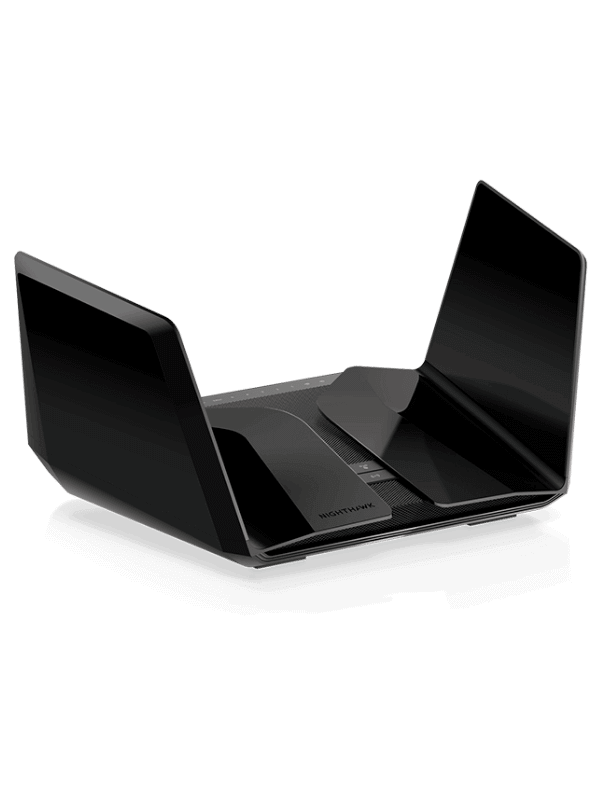
- Type: Wi-Fi router
- Tested max speed: 1203.59 Mbps
- Recommended for: internet plans under 1200 Mbps
- Wireless standard: Wi-Fi 6e
- Warranty: One year
Pros
- Very fast
- Good range
- Tri-band for more bandwidth
Cons
- Expensive
- Lacking features
If you’re all about hardcore speed and have a big internet plan to boot then you may wish to stretch your budget to the almighty speeds of the Netgear Nighthawk AXE11000 RAXE500.
This router is Wi-Fi 6e ready (it has a third 6 GHz band on top of the standard 2.4 GHz and 5 Ghz) which means it can achieve unbelievable speeds. It clocked in at some 1203.59 Mbps in our tests, making it one of the fastest home routers one can buy.
With any speed over 1000 Mbps, you’re laughing. That would allow you to stream Netflix in Ultra HD on over 40 devices at the same time. And it would only take 11 minutes to download as much as 100 GB. Nice.
The RAXE500 isn’t going to be a problem for those with larger apartments either. We found that it can sustain a range of 100-110ft, plenty for bigger spaces. If you want to go even further than that, there’s the option to upgrade to Mesh by buying extra satellites so that you can roam around your large flat without having to reconnect to individual networks.
There are a couple of slight issues with this router and they revolve around the features. There is no QoS here, which means you won’t be able to direct network attention to particular devices. The parental controls are a little limited as well, so it’s not an ideal router for those with young children.
On top of that, you won’t get two years’ warranty like some of the other routers on our list, let alone a limited lifetime one like the others. Netgear only gives you a year which is the bare minimum. It is a reliable router, but this lack of warranty might be of concern to some people.
That being said, you do get some cool features. The Nighthawk’s security is very strong thanks to Netgear Armor, although you do have to subscribe to unlock all the features of this.
So, no matter how many people live in your apartment, the Nighthawk would be enough for you as long as your internet plan justifies paying for it. Just consider whether you’re going to miss the parental controls and QoS.
#3 Best for budget: TP-Link Archer A7
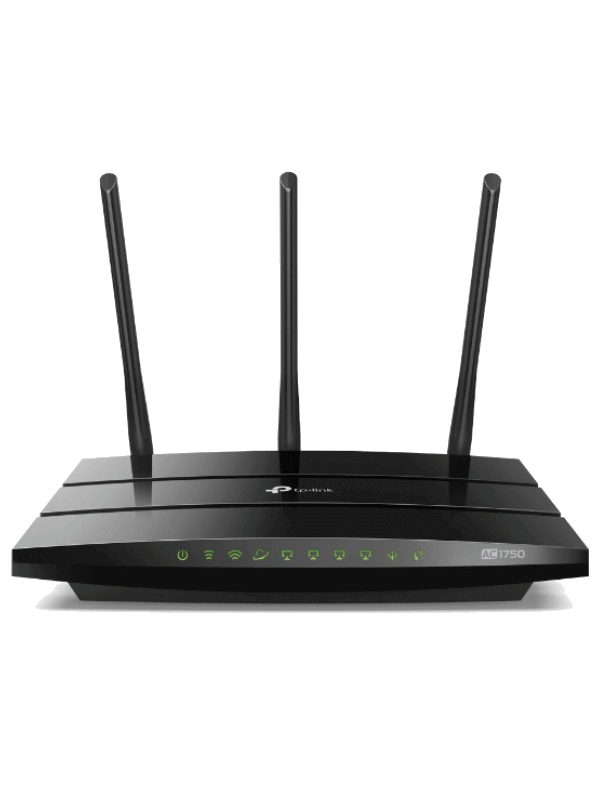
- Type: Wi-Fi router
- Tested max speed: 438.89 Mbps.
- Recommended for: internet plans under 400 Mbps
- Wireless standard: Wi-Fi 5
- Warranty: Two years
Pros
- Fast for price
- Affordable
Cons
- Lacks features
- Easily scratched
TP-Link is here to prove that you don’t need to spend a fortune to get good performance from a router. The Archer A7 is a cracker for those with internet plans up to 400 Mbps.
We calculate this based on our download speed tests, where the A7 managed a top speed of 438.89 Mbps from a Wi-Fi 5 device. That’s really impressive, and is actually faster than some more expensive models. It’s especially good if you don’t even have Wi-Fi 6 devices.
The speed of the A7 is more than enough for a family living in an apartment. Don’t be put off by the fact that this isn’t a Wi-Fi 6 router. Anything over 400 Mbps is really strong, actually.
The range here is a little limited at 80-90ft but that’s going to cover most apartments with ease. We don’t need a router with a wide range for apartment life! If you do want to extend it further, you’ll need to use a traditional Wi-Fi extender as there are no Mesh capabilities here.
What about extra features? There are a couple of cool ones including the Tether app which makes it really easy to set up your router and control the settings.
That includes QoS for the times when you want to designate more power to particular devices on the network. That being said, the QoS is very limited so don’t expect too much from it.
You may not wish to buy this router if security is a big concern for you as it is an older model and therefore might be limited by less frequent updates. Plus, we found that it was easily scratched so look after it if you do buy it!
Overall, it’s a great router for those wanting to save some cash. And why wouldn’t you, especially if you live in an apartment and not a massive home?
#4 Best for features: Google Nest Wi-Fi

- Type: Wi-Fi Mesh router
- Tested max speed: 87.76 Mbps
- Recommended for: internet plans under 100 Mbps and IoT apartments
- Wireless standard: Wi-Fi 5 router
- Warranty: Two years
Pros
- Affordable
- Looks great
- Great features with Home integration
Cons
- Poor performance
Fancy your apartment as somewhat of a smart one? In that case, you’ll probably want to integrate the awesome Google Home features of the Google Nest Wi-Fi Mesh system.
We’re talking about Internet of Things (IoT) devices such as security systems, thermostats, and lighting. A lot of fun and a big part of the future, we feel!
The best thing about this router is the way it hooks up to Google Home. So if you have a number of other smart devices that can do that too, definitely consider Google Nest… but only if you have an internet plan of 100 Mbps or less.
That’s because this is a slow router. It only managed a top speed of 87.76 Mbps in our test and that’s partially because it only supports Wi-Fi 5 which is odd for Google. Especially considering that Wi-Fi 5 doesn’t have to be slow like we saw from the TP-Link Archer A7.
That being said, 87.76 Mbps is likely to be enough for two or three people living in an apartment. It’s still 3 lots of Ultra HD Netflix streams at the same time. You might just find that it takes a little longer to download things.
It also manages to hold onto its speed throughout the network, even when you’ve connected a handful of devices. Google recommends a max of five but we feel that they’re being pretty conservative with that.
The range of the original router isn’t amazing at 60ft, nor is the range of each satellite at 50ft. However, they are quite affordable so you won’t have to break the bank to go for this Mesh system.
Another cool feature we like here is that each piece of hardware doubles up as a smart speaker and supports voice control so you can speak to your home wherever you are and control the network settings or those of the other devices on your Google Home app.
So if you don’t have a really fast internet plan and you do want to build up your Google Home apartment through IoT devices, this Mesh option is a lot of fun.
#5 Best for larger apartments: TP-Link Deco S4
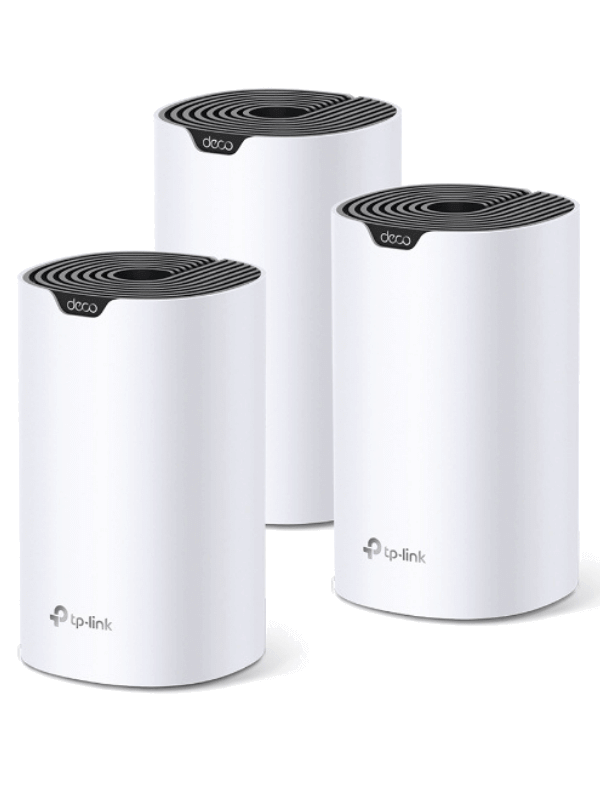
- Type: Wi-Fi Mesh router
- Tested max speed: 317.27 Mbps
- Recommended for: Anyone with a large apartment and an internet plan under 300 Mbps
- Wireless standard: Wi-Fi 5
- Warranty: Two years
Pros
- Reasonable price
- Excellent range
- Great features (QoS, Parental Controls, etc)
Cons
- Not the fastest kit
There are some apartments where range comes into the equation. If your apartment is over around 2000 sq ft, you may wish to look at the awesome Mesh system of the TP-Link Deco S4. But, only if your internet plan is less than 300 Mbps.
That’s because this Mesh network topped out at 317.27 Mbps. It’s not bad for a Wi-Fi 5 system though. 300 Mbps is still going to be more than fast enough for most families and perhaps even small businesses.
It’s worth noting that you can get much faster Mesh systems but they’ll be a lot more expensive. We feel that the Deco S4 represents great value, considering especially that it’s cheaper than the less powerful Google Nest Wi-Fi.
It also offers a better range than Nest Wi-Fi as it is technically possible to connect up to 10 satellites to the network. You probably won’t get great performance that far away from the router though.
Just like with most TP-Link routers, you can control the router settings (QoS, parental controls and more) through a neat app on your smartphone. The app is great for setting up the system and adding satellites to it as well.
You will only get two years’ warranty with the TP-Link Mesh systems as opposed to the actual routers for some reason, but that’s still more warranty than some brands have to offer.
So if you’re living in a big apartment and don’t have an internet plan any faster than 300 Mbps, pay close attention to this Mesh system. It does a great job for a very reasonable price.
#6 Best for gaming: ASUS RT-AX88U
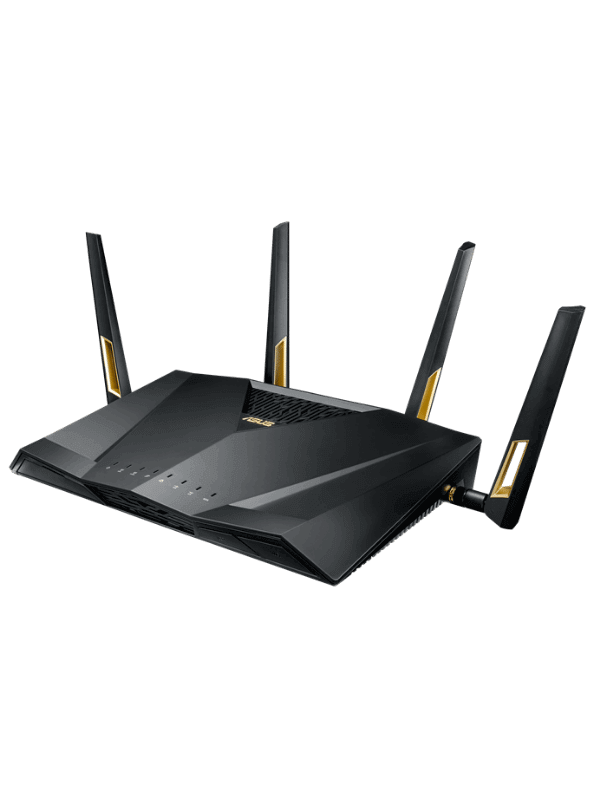
- Type: Wi-Fi router
- Tested max speed: 927.17 Mbps
- Recommended for: internet plans under 900 Mbps
- Wireless standard: Wi-Fi 6
- Warranty: Two years
Pros
- Very fast
- Extremely good range
- Loads of great features
Cons
- A little pricey
Hardcore gamers out there will know how important it is to have a really serious internet connection and that’s what’s so great about the ASUS RT-AX88U.
This thing is seriously fast, and without even having to use Wi-Fi 6e like the Netgear Nighthawk. We managed to get a whopping 927.17 Mbps out of it. Combine that with an awesome range of 100-110ft and you know you’re dealing with a decent piece of kit.
But that’s not the only thing that makes it great for gamers. The RT-AX88U has one of the best QoS features in the game. It does a fantastic job of directing network attention to a specific device, and even comes with a ‘gaming’ mode which will help you get your ping way down, reducing gaming lag. Gamers rejoice!
There are even more cool features as well. ASUS’s AiProtection Pro security is substantially good and you’ll get it free for life when you purchase this router. This will give you the extra peace of mind to know that every device on your network is safe.
It’s not a cheap router by any means, but that’s to be expected from a device that performs as well as this. Realistically, the price is the only thing we don’t love about this router. A cracker for those looking for peak performance with the internet plan to match it!
#7 Highest security: ASUS RT-AX56U
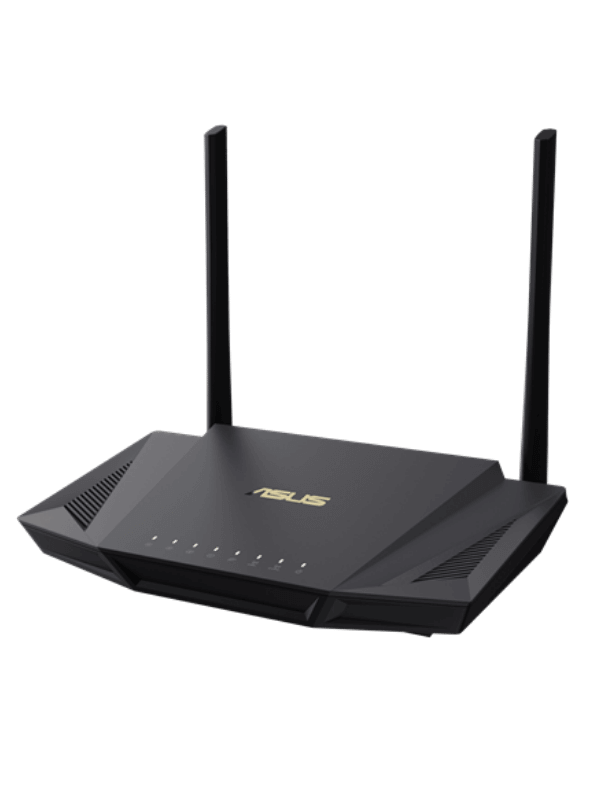
- Type: Wi-Fi router
- Tested max speed: 754.02 Mbps
- Recommended for: internet plans under 700 Mbps
- Wireless standard: Wi-Fi 6
- Warranty: Two years
Pros
- Great value
- Surprisingly quick speeds
- Good features
Cons
- Poor range
You don’t have to fork out for the high-level ASUS RT-AX88U if you want ASUS’s awesome security features. The much more affordable RT-AX56U includes it too, and offers great performance.
Just like the RT-AX88U, you’ll get AiProtection Pro meaning there’s the amazing antivirus security we love from ASUS. There’s also the same great QoS to direct network attention to your computer, games console or any other device.
Anyone who has a slower internet plan (but not that slow by any means!) of 700 Mbps or less will find a lot of joy from this router and for a great price, too. That’s because we managed to get an impressive top speed of 752.02 Mbps out of it.
Just like with the whole ASUS router range, you’ll get two years of warranty here. Great for that extra peace of mind.
Just be aware that this router doesn’t have a great range. We found that it topped out between 75 and 80ft. That could be a lot better, but it’s still enough for a lot of apartments.
You can also connect Mesh networks using ASUS’s AiMesh technology. At that point, it’s not much of a budget system anymore though. Other than the range, there’s not much you won’t like about this router! Perfect for those medium-sized apartments.
Apartment Router Buying Guide
We’ve put together a few key issues that should be considered when you’re deciding which router to pick up for your apartment. Check them out! And if you still need more info after you’ve finished, our ultimate buying guide will give you that.
Wi-Fi 5 vs Wi-Fi 6
Wi-Fi 5 and Wi-Fi 6 differ more on performance than range so it really depends on your internet plan and intended usage.
Wi-Fi protocol was upgraded back in 2019 with the introduction of the new standard, Wi-Fi 6. This brings in faster speeds (up to 250% faster, no less!) and a (slightly) better range.
If you feel like you need that extra juice from Wi-Fi 6 and you have the internet plan, then go for it! But as you might expect, it does cost a fair amount more money to buy a Wi-Fi 6 router than a 5 one.
When we explored Wi-Fi 5 and Wi-Fi 6, we found that any internet plan of 300 Mbps or less is probably not worth a Wi-Fi 6 router. Between 400 and 500 Mbps, you could get away with either. Anything 600 Mbps or more is definitely worth Wi-Fi 6 though!
Dual-band vs. Tri-band routers
Most routers these days have at least 2 bands, 2.4 GHz and 5 GHz. 2.4 GHz has a wider range but a slower speed whereas 5 GHz is quicker but doesn’t travel as far.
In our experience, a 5 GHz band on most routers will cover a medium-sized apartment. At least a couple of bedrooms’ worth! So you can still get quick speeds on this band. And remember, you can always upgrade the distance with a Wi-Fi extender if you feel the need.
So, with that in mind, what’s the deal with tri-band routers? Well, they have a third band: an extra 5 GHz one. This could be a good thing for apartments. If there are two 5 GHz bands, more devices can get better performance on this band as it frees up congestion.
So if you live with a few people, stream or download a lot of stuff, or often have guests over, the tri-band router option could well be worth it for you. However, it is quite a bit more expensive so make sure you consider that.
For more info on the difference between these two types, check out our comparison article.
Is Wi-Fi 6e worth it for an apartment?
It certainly can be. Wi-Fi 6e’s top performance has a shorter range but that’s usually okay in an apartment.
And that comes from a different type of third band to the extra 5 GHz one mentioned above. This time, we’re dealing with a 6 GHz band. It’s even faster than the 5 GHz one but it does have a shorter range. The Nighthawk is a good example of how fast Wi-Fi 6e can be with its belting 1200 Mbps.
Because it has a shorter range still, it’s not going to be much good for massive apartments. But even then, a lot of Wi-Fi 6e routers are Mesh ready meaning you can extend them with ease. Wi-Fi 6e routers can be super expensive though, so keep an eye on that.
Only buy this type of router if you have a really fast internet plan.
How much does range matter in an apartment?
Not really! Most routers should be able to handle most apartments. You won’t need to worry about range if you have an average-sized apartment.
And even if you do find yourself struggling for ranges in the far reaches of your apartment, you can always opt for a Wi-Fi extender to boost your range.
We should also mention Mesh at this point. Mesh is a Wi-Fi technology that allows you to connect to other satellites without changing your connection, meaning you can head further and further away from the original router seamlessly.
Mesh is going to be more expensive but it could certainly be worth it if you have a large apartment.
Not sure whether to bother with Mesh or just go for a Wi-Fi repeater (if anything at all)? We compared the two so you don’t have two. You can read all about it here.
Extra features
There aren’t really any features that will help you in an apartment specifically but there are a few that are very good to have.
For example, there’s QoS. Quality of Service allows you to dedicate more network attention to one, two or three devices on the network. That’s useful if you need to download a large file or embark upon a gaming session.
If you live with kids, parental controls are a must have. This restricts access to adult or malicious content to particular devices on the network.
One more thing really worth considering is security. If your router has weak security, it could compromise every device that’s connected to it. Definitely do not neglect the likes of antivirus!
FAQ
Here are some common questions regarding routers for apartments.
Which router should I get for my internet plan?
There’s no doubt that the internet plan you’re provided by your internet service provider should be one of the main things you base your new router decision on.
So make sure you check that out against our measured top speeds for the routers above.
It’s fair to say that most of the routers on our list today will be fast enough for most internet plans. The only time this won’t be the case is if you have a superfast connection.
However, make sure you consider how far away from the router you’ll be looking to sustain a fast connection, as speed decays over distance using Wi-Fi.
Are there any routers with a range too short for an apartment?
You’d be hard-pressed to find a router that’s too short for a small or medium sized apartment but it could be worth checking if your apartment is on the larger side. It’s also worth considering the range of the 5 GHz (or 6 GHz) band specifically if you want those rapid speeds.
Will other apartments in my block dampen my internet speed?
It is possible that your neighbors’ Wi-Fi signals could interfere with yours and this is especially the case if you have signals above, below, left and right of your apartment.
This is more the case with the 2.4 GHz band. It’s something to consider if you’re looking at a budget router.
You can often get around this by repositioning your router, changing to the 5 GHz frequency or changing the channel if your router allows you to do this.
A few final thoughts on apartment routers
When it comes to apartments, the range isn’t going to be much of a problem. So it really comes down to just speed and extra features, unless you have a particularly massive apartment.
We feel that the best Wi-Fi router for an apartment is the TP-Link Archer AX50. That’s based mainly on a great performance, value, and features. But it could be different for your own situation!
Be sure to double-check what internet plan speed you can get and measure your choice against that. There’s not a lot of point in paying for a router that’s faster than your plan will give you unless it has extra features that you feel are necessary. Enjoy your search!
